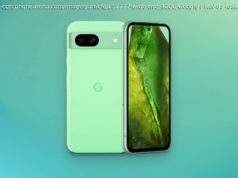iPhone X, Pixel 2, Nokia 8 and more, here are the top phones of 2017 in ascending order.
2017 is nearing an end and therefore it becomes imperative now to look back and list all the top headlining smartphones of the year: there’ve been a lot of them actually so it’s been all the more difficult to pick the top contenders this year. But anyhow, here are the top phones of 2017 in ascending order.
The Honor 8 Pro is simply a bigger and more powerful Honor 8 with the same dual camera setup packed inside an all-metal unibody design, and just like the Honor 8, the Honor 8 Pro is also a fantastic value for money buy especially in the camera department.
The Honor 8 Pro has two cameras on the rear — dual 12-megapixel Sony IMX286 with dual-LED (dual tone) flash — wherein one takes monochrome shots the other takes photos in colour (RGB). The phone’s software algorithm then merges both the images into one and creates the final photo. The monochrome images can take in 300 per cent more light and 50 per cent more contrast than coloured photos, according to the makers. So basically, the phone can ideally take better low-light photos than rival top-tier phones thanks to its dual-lens system, if the company is to be gone by. And it does. The Honor 8 Pro, in addition, also has an 8-megapixel camera on the front.
Elsewhere, the phone comes with a 5.7-inch Quad-HD (2560×1440 pixel) screen and Huawei’s home brewed octa-core HiSilicon Kirin 960 processor clubbed with Mali G71 MP8 GPU and 6 gigs of RAM, and 64GB of internal storage which is also expandable.
The dual-SIM Honor 8 Pro runs Android Nougat-based Emotion UI 5.1 and support 4G LTE. There’s USB Type-C for charging and data syncing and a rear-mounted fingerprint scanner for security. The Honor 8 Pro is further backed by a 4,000mAh battery.
Here is what we said about the Honor 8 Pr o in our full review:
« The Honor 8 Pro is an accomplished all-rounder — it has a great high-resolution display, mighty impressive cameras, top of the line internals, snappy performance, classy looks and impressive battery life. »
The Moto G5S Plus — which is being billed as special edition Moto G5 Plus — offers upgrades primarily in the camera and battery departments. There are a few tweaks here and there, but overall, the Moto G5S Plus should technically entail in better photos and better battery life than the ‘not so special’ edition Moto G5 Plus.
« Dual 13MP rear cameras (one colour + one monochrome) in the Moto G5S Plus, combined with special photo enhancement software, makes it easy to do more with your photos. Selective focus mode makes it easy to take professional looking portraits on your phone, adding a beautiful blurred background effect. Or, have fun trying selective black and white coloring or replace background mode which give your photos a whole new look, » says Motorola.
The dual camera system on-board the Moto G5S Plus should technically entail in better low light photos and photos with shallow depth of field effect or bokeh, something on the lines of an iPhone 7 Plus. Also, the monochrome sensor on-board, can additionally, help shoot photos in true monochrome or black and white so that there quality would be better in comparison to photos that are tweaked into B&W via image filters.
Here is what we said about the Moto G5S Plus in our full review:
« The Moto G5S Plus comes across as a pretty great smartphone – it has butter smooth software, a premium all metal design, a vivid display, a great primary camera for the price, solid battery life and powerful internals. »
Backed by a premium design, top-notch performance and fantastic battery life, the Redmi Note 4 still remains to be the smartphone to beat at its price point. Follow up to the much successful Redmi Note 3; the Redmi Note 4 exists primarily to correct the camera shortcomings of its predecessor, according to the company. The phone comes with a 13-megapixel camera on the rear with f/2.0 aperture, Phase Detection Autofocus and dual-LED (dual-tone) flash. On the front, the Redmi Note 4 comes with a 5-megapixel camera.
Also Read: iPhone X, Nokia 8, OnePlus 5T: Meet the phones with the best displays in 2017
The Redmi Note 4 boasts of a full-metal body and a rear-mounted fingerprint scanner. It comes with a 5.5-inch 1080p IPS LCD display and is powered by a Qualcomm Snapdragon 625 processor clubbed with Adreno 506GPU. The base 2GB RAM and 32GB storage version of the Redmi Note 4 sells for Rs 9,999 and supports expandable storage of up to 128GB via a hybrid micro-SD card slot as well. The dual-SIM phone runs Android Marshmallow-based MIUI 8 and supports 4G LTE (VoLTE-ready). The Redmi Note 4 is further backed by a 4,100mAh battery.
Here is what we said about the Xiaomi Redmi Note 4 in our full review:
« The Redmi Note 4 is an all-rounder that’s also very affordable. »
The Nokia 8 is HMD Global’s top-tier phone right now. Unlike the Nokia 6 that came with sharp edges, the Nokia 8 comes with subtle curves that seamlessly wrap around the front. The front, meanwhile, is chamfered — and comes with Corning Gorilla Glass 5 protection — to enhance grip and ergonomics. The Nokia 8, much like the Nokia 6, is an all-metal smartphone carved out of 6000 series aluminum but two of its variants — Polished blue and Polished copper — have been polished to near perfection so they look like all-glass phones. They are glossy. The Tempered blue and Steel variants are meanwhile meant for someone who likes it sober.
The Nokia 8, in addition, comes with IP54 certification which makes it splash-proof (but not water-proof). It comes with an always-on display — Glance Screen — as well.
The Nokia 8 comes with a 5.3-inch quad-HD IPS display with 700 nits of brightness, a Qualcomm Snapdragon 835 processor clubbed with 4 gigs of RAM under the hood, and 64GB of internal storage which is further expandable by up to 256GB via a hybrid micro-SD card slot. The phone is backed by a 3,090mAh battery and supports Qualcomm’s Quick Charge 3.0 fast charging.
Although the Nokia 8 doesn’t ship with stereo speakers (or Dolby audio like the Nokia 6) it packs in Nokia’s OZO spatial 360 degree audio technology. It comes with three microphones that allow for 360 degree spatial audio capture while recording videos.
On the camera front, the Nokia 8 comes with a dual camera system on the rear — 13MP RGB+13MP Monochrome sensor — assisted with Optical Image Stabilisation, laser and phase detection autofocus along with a dual-LED flash. The dual camera system has been fine tuned by Carl Zeiss. The front camera — which is the same 13MP as the primary sensor on-board the rear — has been given a similar treatment. This is to allow for Dual-Sight, a feature that lets a user to simultaneously use both the rear and front cameras to take stills/record videos. Think of it as picture-in-picture. If that wasn’t enough, the phone also allows for live broadcast of videos shot using Dual-Sight on to social media platforms like Facebook.
Here is what we said about the Nokia 8 in our full review:
« The Nokia 8 is not cutting-edge. Nor is it glamorous. But it is elegant, refined and solid. The smartphone looks classy, is very durable, is extremely fast, slick and fluid and has cameras that produce great images. »
The Mi A1 in typical Xiaomi fashion is a phone that’s high on specs and low on price. But, it’s unlike any other Xiaomi phone that you’ve seen before. The Mi A1 does not ship with Xiaomi’s custom ROM MIUI. It’s an Android One-based phone that runs a near 100 per cent version of stock Android.
The Mi A1 runs stock Android 7.1.2 Nougat out-of-the-box and will be updated to the recently announced Android Oreo by the end of this year, Xiaomi has confirmed. Xiaomi (and Google), in fact, went so far as to say that the Mi A1 will also be getting Android P – or whatever Google decides to call the Android O successor – when it launches later next year.
Just like the Redmi Note 4, the Mi A1 is also powered by a Qualcomm Snapdragon 625 processor. Unlike the Redmi Note 4, the Mi A1 has stock Android at its core. The combination — a deadly one at that — ensures the Mi A1 feels faster in almost every sense of the word in comparison to the Redmi Note 4 that runs MIUI: a custom ROM based on Android.
The Mi A1 further comes with a dual camera setup on the rear — 12-megapixel + 12-megapixel — where one lens is wide-angle while the other is telephoto (or zoom lens). This dual camera system offers 2X optical zoom and 10X digital zoom (just like the iPhone 7 Plus) and therefore should technically result in clearer distant shots and professional bokeh effects in portraits. The system is further aided with phase detection auto-focus and a dual-LED (dual-tone) flash but there is no optical image stabilisation. On the front, the Mi A1 comes with a 5-megapixel camera.
Elsewhere, the Mi A1 comes with an all-metal body that looks remarkably like the iPhone 7 Plus. The phone comes with a rear-mounted fingerprint scanner and USB Type-C for charging and data syncing. It comes with a 5.5-inch 1080p screen, 4 gigs of RAM, 64GB of internal storage which is also expandable, and a 3,080mAh battery under the hood.
Here is what we said about the Xiaomi Mi A1 in our full review:
« The Mi A1 is essentially a Xiaomi phone running stock Android and to cut short the chase here: it flies like no other phone at its price point. »
This year’s Galaxy S8, Galaxy S8+ and Galaxy Note 8 are all so very similar that it all narrows down to one thing: do you or do you not, need the S-Pen? Dual cameras, unless you really want them, are just an added luxury. Take the S-Pen away (also the dual cameras) and the Galaxy Note 8 is simply a boxier (and slightly bigger) Galaxy S8+. Quite simply put, to be or not to be is the question the Galaxy Note 8 must repeatedly ask itself.
Frankly speaking, it shouldn’t. The Galaxy Note 8 is in a league of its own.
The Galaxy Note 8 may be a bigger Galaxy S8+ — with an S-Pen stylus and dual cameras — but in the grand scheme of things, it’s all the more compelling than the Galaxy S8+ and not the other way round.






